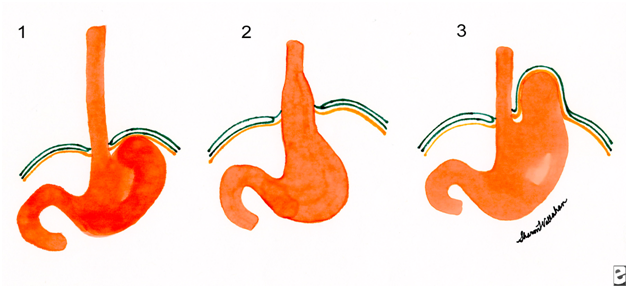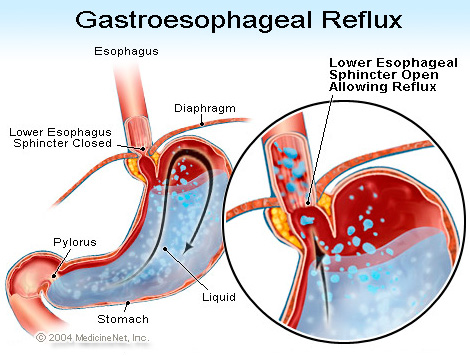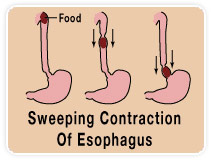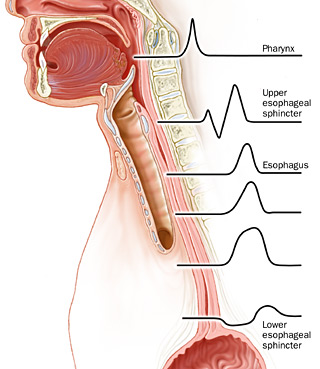- Acid Reflux
- Esophageal Spasm
- Barrett’s Esophagus
- Cancer of the Esophagus
- Achalasia
- Other GI problems

Heartburn, also called Acid reflux (Heart burn) sometimes caused by a Hiatal hernia with Gastro-esophageal reflux (GERD)
Stomach acid that washes up from your stomach into the tube (esophagus) that runs from your throat to your stomach can cause heartburn — a painful, burning sensation behind your breastbone (sternum).
- Normal position of the stomach below the diaphragm
- Sliding Hiatal Hernia, sometimes associated with GERD
- Para-esophageal Hiatal Hernia, usually not associated with GERD
Symptoms of acid reflux and spasm of the esophagus can be uncomfortable and are often misdiagnosed as angina type of pain and vice versa. Usually, it is relatively easy to relate GI pains to food intake or the acid or bile taste in your mouth. Most everybody has episodes of acid reflux on occasion, and about 50% of us have a Hiatal Hernia that never causes any trouble:


Once diagnosed however, it becomes easy to get labeled as a patient with Gastro-esophageal reflux (GERD) and often all symptoms like Angina are then misinterpreted as acid reflux, especially in women, who often have atypical symptoms.
Esophageal spasms are even more easily confused with angina type of pains, and sometimes are only diagnosed after coronary artery disease has been excluded. The diagnosis of spasm requires specialized testing that not only requires a Barium swallow (as seen below), but also testing of the pressure inside your esophagus at different levels (esophageal manometry):

Esophageal testing or manometry measures the pressures and the pattern of muscle contractions in your esophagus. Abnormalities in the contractions and strength of the muscle or in the sphincter at the lower end of the esophagus can result in pain, heartburn, and/or difficulty swallowing. Esophageal manometry is used to diagnose the conditions that can cause these symptoms.
During esophageal manometry, a thin catheter that contains sensors is passed through the esophagus into thw stomach. Patients next swallow sips of water. Esophageal manometry can be helpful in diagnosing a variety of disorders that affect the esophagus. During normal swallowing the esophagus has regular, sweeping contraction waves:
Other tests may include a Continuous (24 Hour) pH Monitor test.
Abnormal cells of the lower portion of the esophagus caised by chronic acid reflux from the stomach into the esophagus (GERD) (see above). It is associated with cancer of the esophagus. In many patients there are no specific symptoms that will distinguish Barrett’s esophagus from a patient with GERD. It is found in 5-10% of GERD patients:

For patients with a diagnosis of Barrett’s it is important to have regular checkups to prevent esophageal cancer to occur in the abnormal cells.
Until the 1970s, the most common type of esophageal cancer in the United States was squamous cell carcinoma, associated with smoking and alcohol consumption as risk factors; since then, there has been a progressive increase in the incidence of esophageal adenocarcinoma, caused by gastroesophageal reflux disease (GERD).
Symptoms include
- Dysphagia (most common); initially for solids, eventually progressing to include liquids
- Weight loss (second most common)
- Bleeding
- Epigastric or retrosternal pain
- Bone pain with metastatic disease
- Hoarseness
- Persistent cough
Diagnosis is usually made with a biopsy of the cancer after which other tests determine how far advanced the cancer has grown. Esophageal cancer may be treated locally, or by surgical removal of all or part of the esophagus (esophagectomy), a procedure with which I have had extensive experience.
Achalasia
In this swallowing disorder, the valve in the lower esophagus doesn’t open properly to allow food to enter your stomach. Instead, food backs up into the esophagus, causing pain.Achalasia is another motor disorder of the esophagus without an obvious etiology. that produces an obstruction at the junction of the esophagus with the stomach.
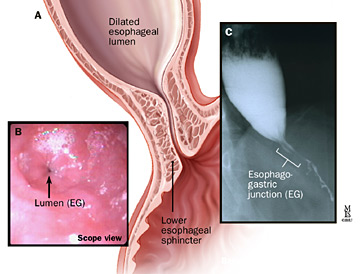 |
| A, Anatomic findings in achalasia; B, endoscopic image; B, radiographic image. |
Symptoms of achalasia is characterized by trouble swallowing of solid food (“dysphagia”). Patients complain of fullness in the chest while eating, with a filling or overflow sensation as the meal progresses. Food is unable to pass effectively into the stomach, resulting in the gradual widening of the esophagus. This causes dysphagia for liquids and solids and regurgitation of food, often many hours after ingestion. Patients may also complain of substernal chest pain and weight loss.
Gallbladder or pancreas problems
Gallstones or inflammation of your gallbladder (cholecystitis) or pancreas can cause acute abdominal pain that radiates to your chest.

